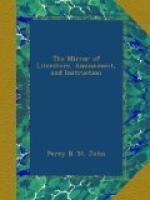The native houses are very neat; they are formed of poles and logs, the roof being covered with the leaves of a species of sagus palm, named hoat by the natives, and highly valued by them for that purpose on account of their durability; the sides are covered with the plaited sections of the cocoa-nut branches, which form excellent coverings.
The natives are a fine-looking and well-formed people; they are of good dispositions, but are much addicted to thieving, which seems indeed to be a national propensity; they are of a light copper colour, and the men wear the hair long and stained at the extremities of a reddish brown colour; sometimes they tie the hair in a knot behind, but the most prevailing custom is to permit it to hang over the shoulders. The females may be termed handsome, of fine forms, and although possessing a modest demeanour, flocked on board in numbers on the ship’s arrival. The women before marriage have the hair cut close and covered with the shoroi, which is burnt coral mixed with the gum of the bread-fruit tree; this is removed after marriage and their hair is permitted to grow long, but on the death of a chief or their parents it is cut close as a badge of mourning. Both sexes paint themselves with a mixture of the root of the turmeric plant (curcuma longa) and cocoa-nut oil, which frequently changed our clothes and persons of an icteroid hue, from our curiosity to mingle with them in the villages—theirs to come on board the ship.




